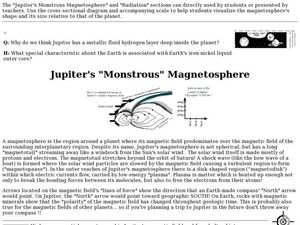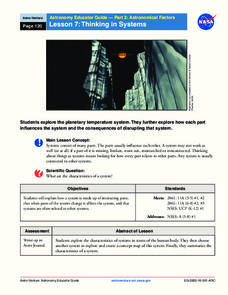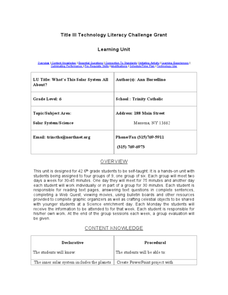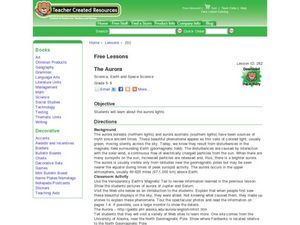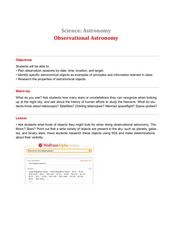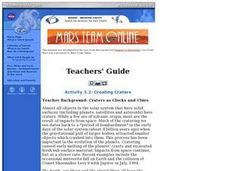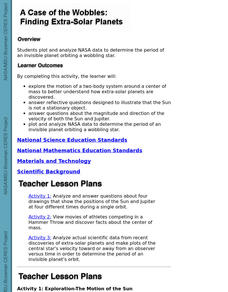Curated OER
What do You Know about Jupiter Already
Learners explore information about the planet Jupiter. In this Jupiter lesson, students answer questions to find out how much they know about Jupiter. Learners research using a website.
Curated OER
Jupiter's Weather Forecast
Students read information about Jupiter and the planet's weather. In this Jupiter weather lesson plan, students read information about Jupiter's weather. Students study a chart about the weather on Earth and Jupiter. Students read a...
Curated OER
Jupiter's "Monstrous" Magnetosphere
Students explore Jupiter's magnetosphere. In this Jupiter lesson, students examine a diagram of the magnetic field that surrounds Jupiter.
Curated OER
Following in Galileo's Footsteps
Students explore the findings of Galileo and research the moons of Jupiter. They construct simple telescopes, and examine the moons for themselves at a star party. They record their findings in a journal.
Voyage Solar System
Round and Round We Go — Exploring Orbits in the Solar System
Math and science come together in this cross-curricular astronomy lesson plan on planetary motion. Starting off with a hands-on activity that engages the class in exploring the geometry of circles and ellipses, this lesson...
NASA
Astronomy Mission Module
Yes, scientists say, there is other life in our solar system! And the best place to look is on Europa, a moon of Jupiter. Here, learners mimic the techniques scientists use to gather information about objects in our solar system, write...
Curated OER
What's "Out" There?
First graders investigate the five outer planets. In this space science lesson, 1st graders read the book Our Solar System and identify the five outer planets. Students create a booklet and write about outer planets.
Curated OER
What's This Solar System All About?
Sixth graders complete a unit of lessons on the solar system. In small groups, they participate in a Webquest, watch movies, complete graphic organizers, and answer questions, create a model of the planets, and develop a Powerpoint...
Curated OER
Life on Plymouth Plantation
Third graders research life of Plymouth Plantation and write letters about life there home. In this Plymouth life lesson plan, 3rd graders complete a webquest as they gather information about the journey to America on the Mayflower and...
Curated OER
Please Ex-Planet!
What is most useful about this lesson plan is the "Student Explanet Worksheet," a set of instructions for collaborative groups to use to collect information about an assigned planet. After students have researched and organized their...
Community Consolidated Schools District 168
Solar System Model Project
Challenge young astronomers to demonstrate their knowledge of the solar system with this fun open-ended science project. Provided with a short list of requirements, students are given the freedom to use their creativity and whatever...
Curated OER
The Aurora
Students study the Aurora Borealis lights known commonly as the Northern and Southern lights. In this space science lesson, students study pictures of the Auroras for Jupiter and Saturn. Students visit the given website for an...
Curated OER
Observational Astronomy
High schoolers research about the characteristics of celestial bodies using a database. In this space science lesson, students collect data such as brightness, apparent color and size by observing the night sky. They share their findings...
Curated OER
Our Solar System
Students investigate the coincidental parade of planets and witness dramatic views of the solar system by researching websites and participating in online activities. They write about their findings.
Curated OER
The Magic School Bus Lost in Space
Students identify the planets by making two models of the Solar System. They create a model that shows the order of the planets and a model that shows the planets sizes as compared to one another. They may write about the planet they...
Curated OER
Voyage to Titan
Learners go to the linked web page "The Nine Planets" to find facts about Titan. They list elements of the solar system and the five planets of the outer solar system. Students find their weight on each planet. Titan is selected from the...
Curated OER
Sky Watching
Middle schoolers explain how our knowledge of the sky has been enhanced by telescopes. They make their own night-sky observations, diagram and describe what they see, and examine pictures taken by telescopes.
Virginia Department of Education
Planet Line-Ups
Should Pluto be considered a planet or a dwarf planet? Scholars research planets in our solar system to understand their similarities and differences. It also includes memory activities related to the order of the planets.
Curated OER
Our Changing View of the Solar System
Students identify and name the eight planets and the five dwarf planets in our solar system. In this space science lesson, students view a slideshow of the planets and label them on an included Solar System chart.
Curated OER
Creating Craters
Learners explore parts of an impact crater and compare and contrast craters found in Earth, the Moon, and Mars. Crater formation is modelled and the relationship of mass, velocity, and size of the projectile to the crater formation is...
Curated OER
Finding Extra-Solar Planets
Students plot and analyze NASA data to determine the period of an invisible planet orbiting a wobbling star. They explore the motion of a two-body system around a center of mass to better explain how extra-solar planets are discovered.
Curated OER
Space Exploration to Find Habitable Planets
Students explore space science by reviewing scientific vocabulary terms. In this planet identification lesson, students identify the nine planets in our solar system and discuss which ones could potentially harbor life at some point....
Curated OER
Remote Sensing - What Can We See When We Can't Touch?
Students discover how remote sensing is used to identify the signatures of life even when the particular life form is not directly observable. They investigate how a satellite "sees" objects on the surface of Earth.
Curated OER
Introduction to Constellations
Students examine constellations. In this astronomy lesson, students study various constellations and identify five major constellations. They will construct a model of one of the constellations.


